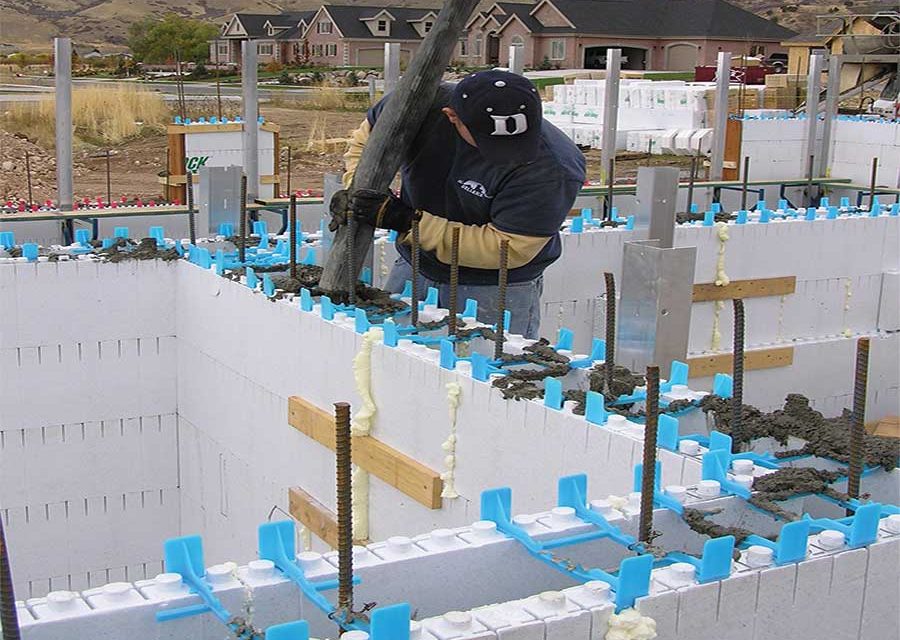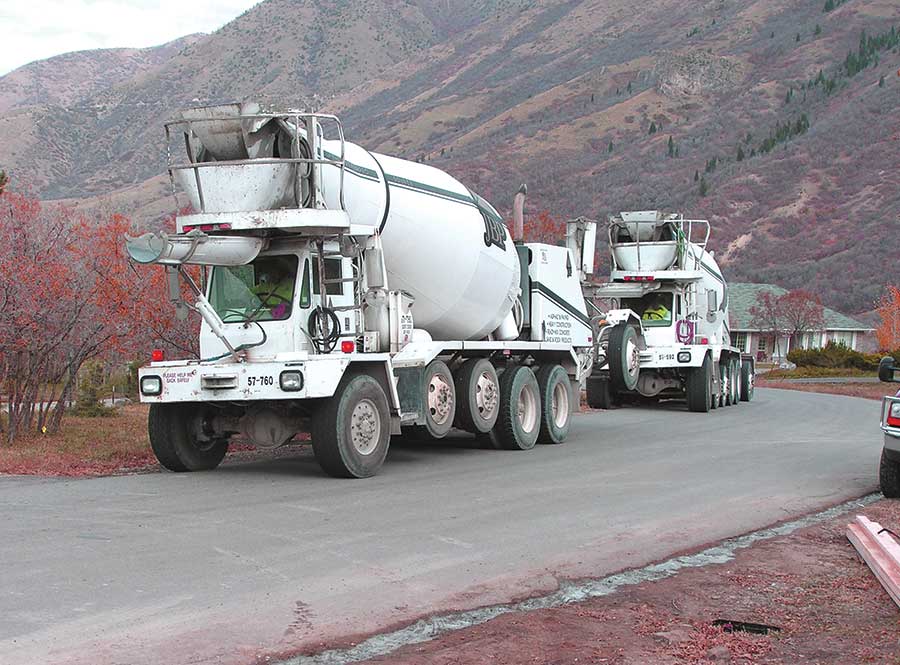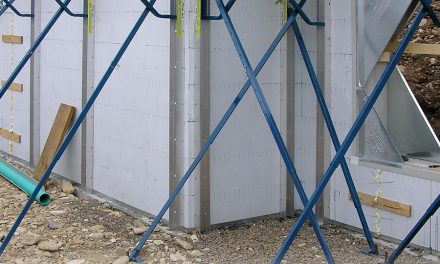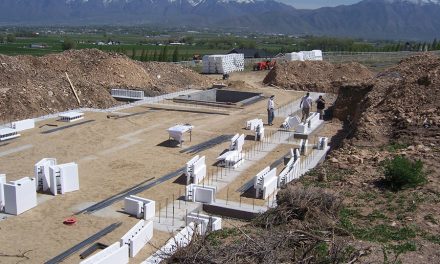A little common sense, and an understanding of the basics will ensure your pours go smoothly every time.
Proper concrete placement is essential in any ICF project. Improper mix design, placement, scheduling or vibration can lead to voids, rock pockets, delays, and in extreme cases, bulged walls and blowouts.
A comprehensive study of all the factors involved to create perfect concrete, perfectly placed in every situation would require a book. But we can take a good look at basics of concrete placement: mix design, placement, and consolidation techniques. With a little common sense, most major problems can be avoided.
Mix Design
Every form manufacturer specifies a mix for their brand of ICF. Find out what that is, and ask if it needs to be modified for your specific project. For instance, a hot summer day in Arizona may require more water than the same wall being poured in a Minnesota winter. Likewise, the width of the wall cavity and amount of reinforcing steel may necessitate a higher slump or smaller aggregate.
Your local ready-mix plant is another good source. Most are already familiar with ICFs. A surprising number of them have become form distributors, and know first-hand what mix design works best in your area.
A 3,000 psi mix with 3/8-inch aggregate is typical. It should be flowable, but not too soupy. A slump of 5 ½ to 6 inches is about right for most applications. If you are using a post-and-beam or waffle-grid ICF, such as ReddiForm or ICE Block, you may want a higher slump. Be aware that the mix taken from the back of the concrete truck may not be the same as what’s coming out of the pump. (It’s usually slightly soupier after pumping.) However, unless the job is enormous, the difference is small enough that it’s not worth testing.
Admixtures are becoming increasingly common. Plasticisers increase flowability without adding water. They also contribute to high early strength, and are quite cost-effective. Wait until the truck is at the jobsite before adding plasticisers; some will lose their effectiveness if there are delays.
Pumping aids, which help the mix flow smoothly through the boom, are also common.
In recent months, there has been a lot of talk about steel fiber. Philip Constantini, a respected ICF consultant and presenter at the 2006 World of Concrete, says steel fiber is becoming cost competitive. “At 45 pounds per cubic yard, it will replace #4 rebar on 18 inch centers. The cost is about the same, but it saves on labor.” Constantini estimates that on a typical basement, fiber saves about half a day of labor.
He cautions, “Be sure to tell your pump operator that you’ll be using steel. He will probably want to order a few yards of grout, and some will refuse to pump.”
Self-consolidating concrete (SCC) is just starting to hit North American markets. SCC is so thin that it “flows like chocolate milk” according to one user. No vibration is necessary, but concerns about form pressure, strength, and price have limited its use. SCC costs from $20 to $50 more per yard than regular concrete.
Lastly, you may want to have a few bags of set retarder on site. Jobsite delays, heavy traffic, and hot weather can all create situations when you need it.
Scheduling
With a little planning, however, you can eliminate surprises.
First, be sure your site is ready for concrete on the day the pump is scheduled. Ensure bracing is secure, and that scaffolding and railings are in place well before the pump arrives.
Schedule the pump truck to arrive at least an hour before the concrete. He’ll need the time to set outriggers, unfold the boom, and prime the pump. Trucks from the batch plant should be scheduled to arrive about 25 minutes apart.
Placement
Yes, it is possible to fill ICFs without a pump truck—just like it’s possible to build wooden braces and hand mix the concrete—but virtually no one does it because boom pumps are so convenient and cost effective. If your jobsite or geographic location truly eliminates the possibility of a pump truck, look into renting a trailer-mounted concrete pump. A third option is a grout pump or mortar machine. Most contractors, however, consider a good pump truck with an experienced operator a must-have for ICF work.
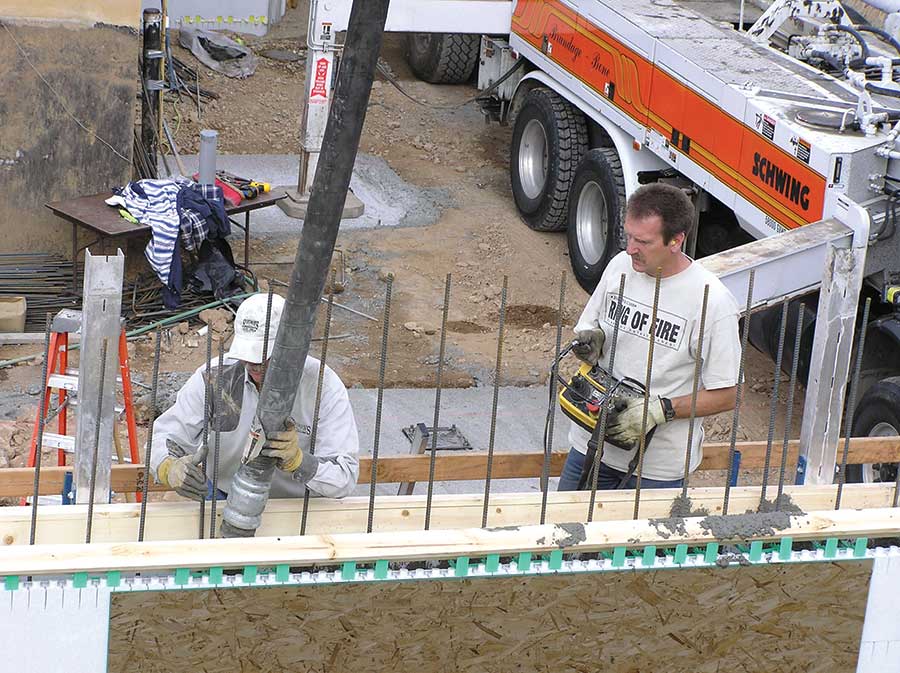
Good communication with your pump truck operator is essential. Note the reducing hose and wooden splatter guards.
Traditionally, pumpers have used two 90º elbows attached to the end of the boom to slow the concrete down before it enters the forms. Some have upgraded to a “ram’s horn” made from four elbows. Be sure something is in place.
For small-cavity forms, look into getting a Ruff-Neck reducing hose from Con Forms. It necks down the 5-inch diameter pump pipe to 3 ½ inches. The reduction naturally decreases the concrete speed, so it doesn’t need elbows or a ram’s horn. It will also greatly reduce splatter and “boom bounce.”
If you can’t get a reducer, request a collapsible hose. Sometimes you can make one from a short length of fire hose.
Whatever system you use, communicate with your pump truck operator. Many will climb on the scaffolding with the remote control around their neck and follow along just a few feet behind you. Good communication is essential.
Fill your openings—below window bucks and around doors—first to ensure good consolidation. Then, work your way around the walls, filling the forms in four-foot lifts. It’s possible to fill a wall 10 feet or higher in a single lift if necessary, but be confident your bracing, stacking, and brand of form are up to
the job.
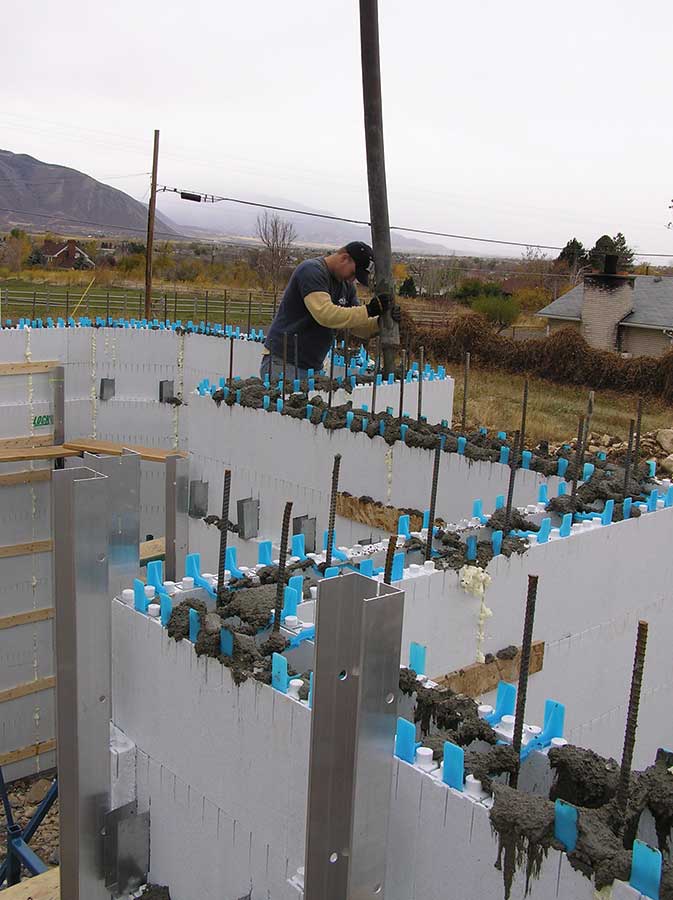
Fill the form in four-foot lifts. If your job requires taller lifts, be sure your bracing, stacking, and form brand can handle it.
If possible, avoid pouring concrete directly into the corners. Instead, hold the hose a few feet from the corner and let it gradually flow into place. Then crimp the hose, move past the corner and continue filling.
If the project won’t be completed in a single pour, cover the interlocks on the block tops to keep them splatter-free. A simple L made from two 1x4s screwed together longitudinally works well.
Mix segregation worries many contractors and code officials, but recent studies have shown that no significant segregation occurs even when concrete is dropped from a height of 8 feet. Above that height, problems may appear. “The problem is that it hits the ties, which scatters the aggregate, and separates it from the matrix,” says Brent Anderson, an ICF consultant.
Consolidation
Unless you use a self-consolidating concrete, you will need to vibrate the mix to eliminate rock pockets and voids. (The April/May issue of this magazine will take an in-depth look at this topic.)
Check with your form manufacturer for vibrating requirements. Most will recommend a “pencil” vibrator with a head no larger than one inch in diameter. The vibrator should follow at least 3 to 4 feet behind the
boom operator.
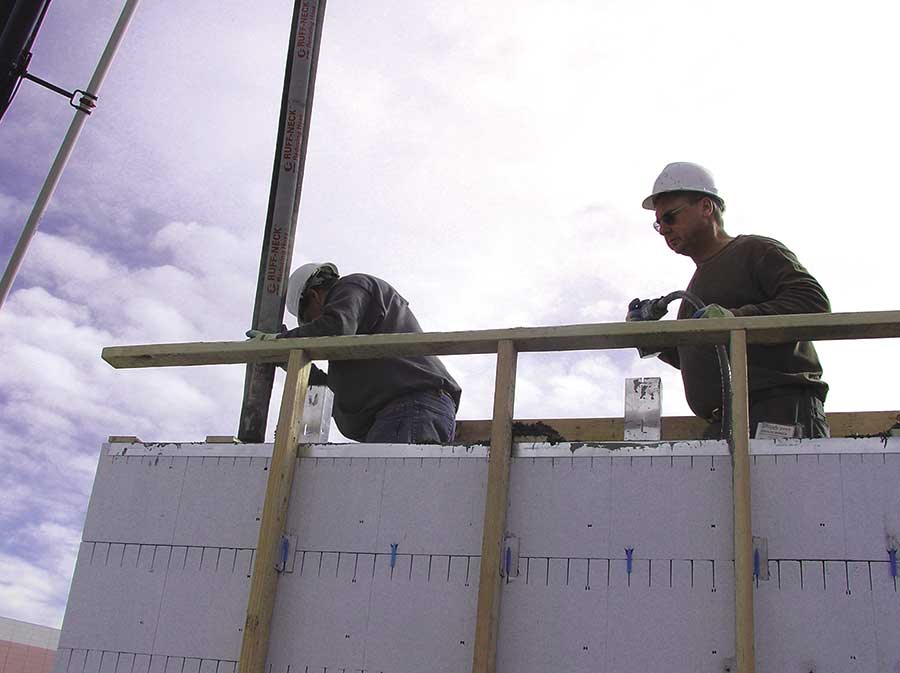
Use a pencil vibrator no larger than one-inch in diameter. It should follow 3-4 ft. behind the boom operator.
In lieu of a vibrator, some contractors will shake the vertical rebar to consolidate the mix. Oztec has taken the idea one step further with a mechanical rebar shaker.
Another common technique is to bang on the outside of the forms with a short length of 2×4. A more effective method is to use a reciprocating saw, such as a Sawz-all, with no blade to vibrate the outside of the forms.
By starting with a good mix, placing it intelligently with a pump truck, and consolidating it carefully within the manufacturer’s guidelines, nearly all concrete placement problems can be avoided.
In a Nutshell
A typical ICF mix design is 3,000 psi with 3/8-inch aggregate and a slump of 5 ½ to 6 inches.
Admixtures, such as plasticisers, pumping aids, and fiber are becoming cost effective.
Pump truck should arrive an hour before the concrete. Trucks from the batch plant should arrive about 25 minutes apart.
Use two 90º elbows or a rams horn to slow the concrete down as it leaves the boom.
A reducing hose can reduce splatter and increase efficiency.
Fill your openings first to ensure good consolidation.
Avoid pouring concrete directly into corners. Instead, hold the hose a few feet away and let it flow into place.
A simple L made from 1x4s can keep block tops splatter-free.
Use a reciprocating saw with no blade to vibrate the outside of the forms.

